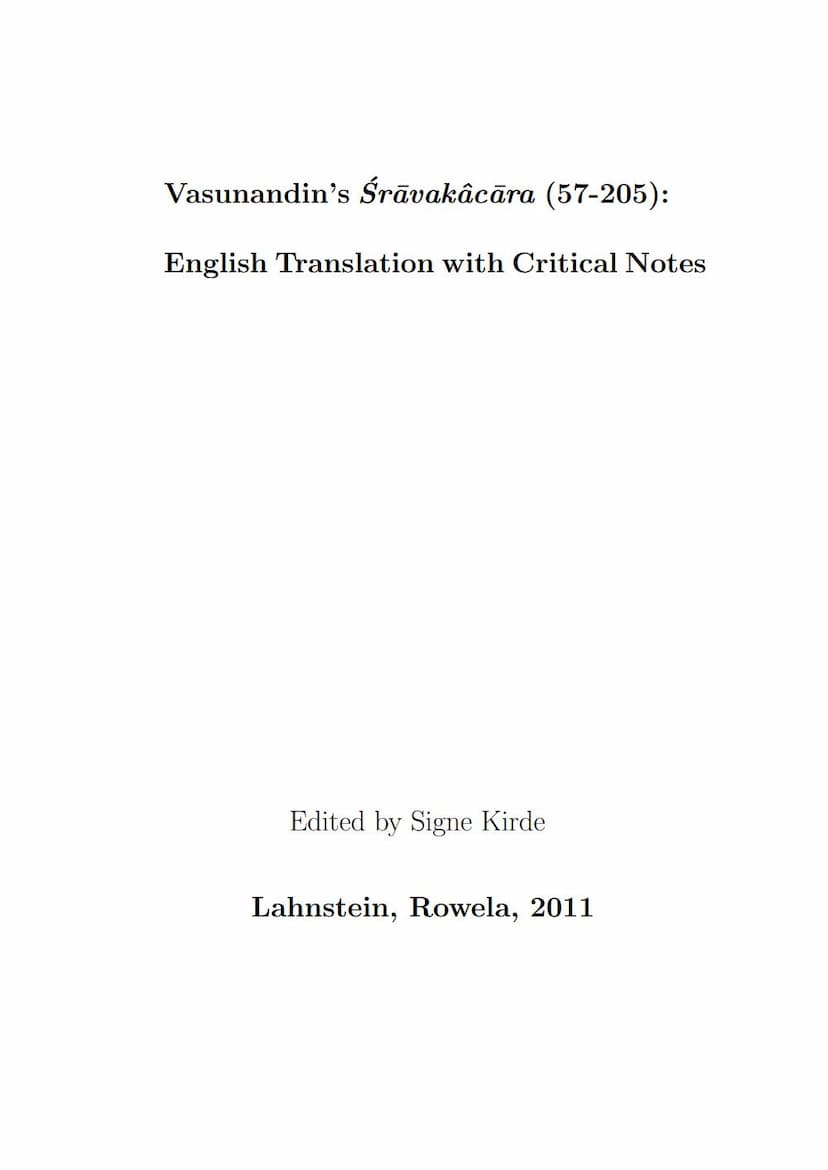Shravakachar Of Vasunandini
Added to library: September 2, 2025

Summary
Here's a comprehensive summary of the provided Jain text, "Shravakachar of Vasunandini" by Signe Kirde, based on the provided PDF excerpt:
Overview:
This document is an English translation with critical notes of Vasunandin's Śrāvakācāra (specifically verses 57-205), a significant Jain text for lay followers. Authored by Signe Kirde, the work is based on her doctoral dissertation submitted to the Eberhard Karls Universität Tübingen. The translation aims to elucidate the Jain doctrine and ethical principles for laypeople, emphasizing concepts of self-purification, the law of cause and effect (karma), and the consequences of various actions.
Key Focus of the Translated Section (57-205):
The translated portion of Vasunandin's work focuses on:
- The Stage of True Insight (Samyaktva): It begins by defining the characteristics and virtues associated with "true insight" (sammatta) for a lay follower (śrāvaka). These virtues include unshakable faith, freedom from greed and doubt, strong conviction, firmness, friendliness, and patronage of the Jain doctrine.
- Seven Vices (Vyasanas): The text then details the negative consequences of indulging in seven primary vices:
- Gambling (Dyūta): Associated with wrath, deceit, pride, and greed, leading to immense suffering in this and future lives.
- Drinking Liquor (Madya): Considered impure and blameworthy, leading to loss of control, indecent acts, and eternal suffering.
- Eating Meat (Māṃsa): Seen as increasing haughtiness and leading to further vices, with the text refuting justifications for meat consumption.
- Sexual Relations with Prostitutes (Veśyā): Described as consuming "rubbish" due to the indiscriminate nature of prostitutes, leading to loss of belongings, abandonment, and severe mental suffering.
- Hunting (Pārāddhi): Deemed a transgression against compassion, which is fundamental to true insight, causing harm to sentient beings.
- Theft (Caurya): Leads to fear, mental anguish, physical punishments, and an inability to enjoy peace or happiness.
- Adultery (Para-dārā): Involving illicit relationships with married women results in suffering, loss of self-respect, and a life of sorrow.
- Examples from Jain Lore: Vasunandin illustrates the severe consequences of these vices by referencing well-known figures from Jain mythology and epics, such as Yuddhisthira (gambling), Rāvaṇa (adultery), and Brahmadatta (hunting), highlighting how their transgressions led to miserable rebirths and suffering.
- Suffering in the Four Destinies: The text provides vivid descriptions of the suffering experienced in different realms of existence:
- Hellish Regions (Naraka): Detailed accounts of the tortures in hot and cold hells, involving dismemberment, burning, piercing, and constant torment, emphasizing the "Geography of Death."
- Animals and Plants (Tiryanca): The suffering of one-sensed and five-sensed beings, including plants, animals, and even microorganisms, detailing the cruelties inflicted upon them.
- Human Beings (Manuşya): The inherent suffering in human life due to separation from loved ones, illness, poverty, and the consequences of past actions.
- Celestial Beings (Deva): Even beings in heavenly realms experience suffering when their karmic merits diminish, leading to a fall from grace and rebirth in lower realms, often characterized by mental anguish and the foreknowledge of their downfall.
Key Jain Concepts and Principles:
The translation and notes highlight several core Jain concepts:
- Karma Theory: The fundamental principle that actions (karma) have consequences, influencing rebirths and the suffering or happiness experienced in various lifetimes.
- Self-Purification (Mula-gunas and Pratimās): The text outlines practices and restrictions for lay followers to purify themselves and progress spiritually, including dietary rules and ethical conduct.
- True Insight (Samyaktva): Presented as the foundation of Jain practice, characterized by right belief, understanding, and conduct.
- Non-violence (Ahimsa): A central tenet emphasized throughout the text, extending to all sentient beings, including plants and microorganisms.
- Compassion (Anukampa/Dayā): Highlighted as a crucial virtue for true insight and a fundamental aspect of Jain ethics.
- The "Substratum Model": Kirde notes that the key motifs and numerical patterns in Vasunandin's work are not exclusively Jain but appear in various religious and cultural contexts across Asia, suggesting a shared conceptual heritage.
- The Importance of Sound: The emphasis on "shrieking" and other sounds of suffering is identified as a prominent stylistic feature, characterizing the distress of sentient beings in all destinies.
Signe Kirde's Contribution:
Signe Kirde's work is significant for providing an accessible English translation of this important Jain text. Her critical notes, based on extensive research and consultation with experts, clarify technical terms, historical context, and stylistic elements. The dissertation was accepted by the Eberhard Karls Universität Tübingen, acknowledging its scholarly merit. The study also touches upon the broader field of Human-Animal Studies, examining Vasunandin's depiction of suffering across species.
Overall Significance:
Vasunandin's Śrāvakācāra (57-205), as translated and analyzed by Signe Kirde, serves as a valuable resource for understanding Jain ethics, the practical application of its doctrines for lay followers, and the rich tradition of Indian religious literature that often utilizes vivid descriptions and numerical patterns for didactic purposes. It underscores the Jain emphasis on ethical conduct, compassion, and the pervasive influence of karma throughout the cycle of rebirth.